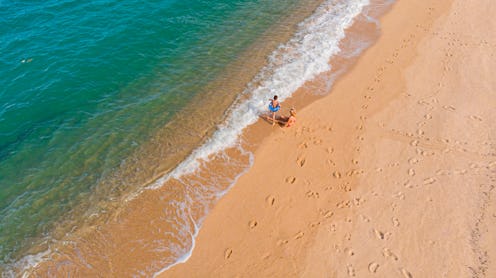
Even if you typically hate all things sand, sun, and salt, you're probably bursting at the seams to dive into some cold ocean water after spending so much time inside. Nearly 75% of millennials are most excited to spend more time outside once social distancing restrictions lift, according to a survey of 2,000 Americans conducted by OnePoll on behalf of Bustle. As sandy paradises start to open again, you might be wondering if it's safe to go to the beach.
"Getting some fresh air is a good thing," says Dr. Tania Elliott, M.D., a clinical instructor of medicine and immunology at NYU Langone. But as you seek the salty fresh air that defines beach adventures, it's important to make sure you're not sending physical distancing on vacation. Dr. Elliot tells Bustle that even when you're soaking up some rays, you should be doing so at least six feet away from others.
In states like Maryland, Hawaii, and Florida, beaches are reopening only for non-stationary exercises like jogging, swimming, and walking, with the caveat that people must maintain at least six feet of social distancing. But if everyone has the same idea to go for an after-work beach walk, crowds can make it difficult to maintain physical distance. On May 12, USA Today reported that Naples, Florida had to close newly reopened shores after overcrowding on the initial weekend of beach openings. However, Naples is now set to reopen those beaches with limited hours, in the hopes that these restrictions will discourage social distancing violations. Cities like San Diego that haven't experienced surges of people to reopened beaches, however, can serve as models for safer ways to move forward elsewhere.
To help prevent packed parking lots and congested stretches of sand, Dr. Elliot advises scoping out a time when the boardwalk won't be crowded. That might depend on the culture of your local surf town, but she says that going right when the beach opens in the morning may be a good bet. Whatever time you go, make sure there are as few people around as possible, she advises. That might mean calling it a day before you even really get started. "If there is a crowd, better to turn around and go back home," Dr. Elliot says. Take note of the time and day you had to retreat, and try a different day or time on your next attempt. Dr. Elliot tells Bustle that while you're there, it's best to avoid using public restrooms and concession stands even if they're open.
A similar logic applies to socializing by the ocean, according to Dr. Elliot. Just because you technically can see other people on the sand, that doesn't mean you should. "Go with your immediate family or people you have been at home with," Dr. Elliot advises. "Don’t use this as a meeting place for friends and family you haven’t seen. You still need to limit contact with people." And yes, she says, limiting contact includes continuing to wear a mask. Keeping a mask on at the beach will be required in places like Los Angeles County, which is reopening its beaches for activities only (no chilling on the sand) on May 13.
If your local beaches are reopening, sunscreen yourself and bring a bottle of water — staying hydrated is always key — but don't plan on bringing your picnic basket. Go out for a quick jog, dive headfirst into some waves, wrap yourself in your towel, and... call it a day. It might not be the same as what you're used to for your beach time, but it'll do for now.
Experts:
Dr. Tania Elliott, M.D., clinical instructor of medicine and immunology, NYU Langone